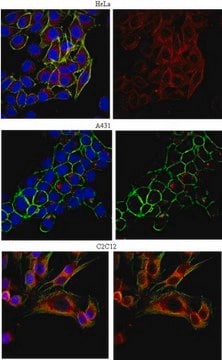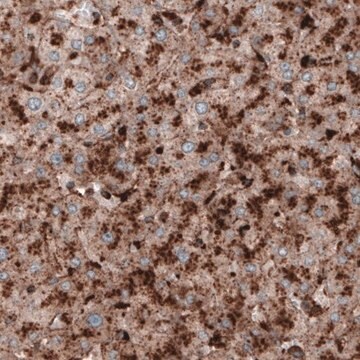AB2971
Anti-LAMP-1 (CD107a) Antibody
from rabbit, purified by affinity chromatography
Synonim(y):
lysosomal-associated membrane protein 1, lysosome-associated membrane glycoprotein 1, Lysosome-associated membrane protein 1, CD107 antigen-like family member A, CD107a antigen
About This Item
Polecane produkty
pochodzenie biologiczne
rabbit
Poziom jakości
forma przeciwciała
affinity isolated antibody
rodzaj przeciwciała
primary antibodies
klon
polyclonal
oczyszczone przez
affinity chromatography
reaktywność gatunkowa
human, mouse, rat
reaktywność gatunkowa (przewidywana na podstawie homologii)
rhesus macaque (based on 100% sequence homology)
opakowanie
antibody small pack of 25 μg
metody
immunocytochemistry: suitable
western blot: suitable
numer dostępu NCBI
numer dostępu UniProt
Warunki transportu
ambient
temp. przechowywania
2-8°C
docelowa modyfikacja potranslacyjna
unmodified
informacje o genach
human ... LAMP1(3916)
Opis ogólny
Specyficzność
Immunogen
Zastosowanie
Apoptosis & Cancer
Apoptosis - Additional
Tumor Markers
Immunocytochemistry Analysis: 1:500 dilution from a previous lot detected LAMP-1 in NIH/3T3, A431, and HeLa cells.
Jakość
Western Blot Analysis: 1 µg/mL of this antibody detected LAMP-1 in 10 µg of EL4 cell lysate.
Opis wartości docelowych
Postać fizyczna
Przechowywanie i stabilność
Komentarz do analizy
EL4 cell lysate
Inne uwagi
Oświadczenie o zrzeczeniu się odpowiedzialności
Not finding the right product?
Try our Narzędzie selektora produktów.
polecane
Kod klasy składowania
12 - Non Combustible Liquids
Klasa zagrożenia wodnego (WGK)
WGK 1
Temperatura zapłonu (°F)
Not applicable
Temperatura zapłonu (°C)
Not applicable
Certyfikaty analizy (CoA)
Poszukaj Certyfikaty analizy (CoA), wpisując numer partii/serii produktów. Numery serii i partii można znaleźć na etykiecie produktu po słowach „seria” lub „partia”.
Masz już ten produkt?
Dokumenty związane z niedawno zakupionymi produktami zostały zamieszczone w Bibliotece dokumentów.
Produkty
Autophagy is a regulated process involved in cell growth, development, and recycling of cytoplasmic components in cells.
Nasz zespół naukowców ma doświadczenie we wszystkich obszarach badań, w tym w naukach przyrodniczych, materiałoznawstwie, syntezie chemicznej, chromatografii, analityce i wielu innych dziedzinach.
Skontaktuj się z zespołem ds. pomocy technicznej








